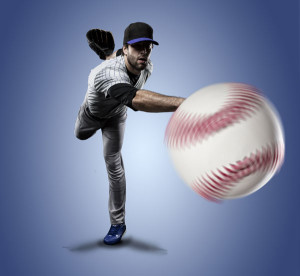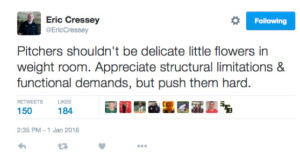Do’s & Don’ts of Training Baseball Players

David Justice
AYC Health & Fitness
Certified Personal Trainer
 Training baseball players…
Training baseball players…
In the world of sports performance training, baseball players are a unique population that needs to be handled with care.
Does that mean they get off easy and don’t have to put any hard work in? Not at all!
It means using a smart mix of movements that will prevent training injuries while bringing about the best preparation for a winning performance on the field. With that in mind, here are several commonly accepted do’s and don’ts associated with training baseball players.
DO’s:
DO Train The Lower Body
The pros hit tape-measure homeruns and throw fastballs in excess of 90mph because they have really big upper bodies, right?
Wrong.
The best baseball players often have some of the strongest lower bodies around, yet that isn’t easily recognizable since we tend to focus on the barrel-chested homerun hitters and the pitchers with arms the size of pythons.
Why is the lower body so important? Because some of the largest and most powerful muscles in your body are located below the belt. The more you strengthen your hips, quads, glutes, and hamstrings, the more powerful your swing and throwing motion will be, leading to harder/longer hits at the plate and increased velocity in the field.
Examples:
- Trap bar squat
- Deadlift (w/ the bar or the trap bar depending on the individual)
- Lunge variations
- Split squats
- Step ups
To quote Eric Cressey, co-founder of Cressey Sports Performance, who has trained 100’s of pro baseball players, “You’ve got to train ass to throw gas!”
DO Utilize the Transverse Plane
There are three planes of motion in which all exercises are categorized:
- Sagittal: forward or backward
- Frontal: side to side
- Transverse: rotational
Traditional strength training exercises such as squats, deadlifts, bench press, and vertical/horizontal rowing variations all take place in the sagittal plane, and they often make up the bulk up baseball training regimens (at least in the offseason). While these are great for building muscle, they don’t really carry over to the most important baseball-specific skills: throwing and hitting.
In order to become more effective at those two skills, you need to begin incorporating exercises from the transverse plane into your workouts so your body can begin learning how to perform these powerful, rotational exercises and movement patterns in a more powerful (yet still controlled) manner.
Examples:
- Rotational med ball throw
- Step-behind rotational med ball throw
- Med ball rotational scoop toss
- Reverse lunge with med ball twist
DO Train to Increase Power
As we’ve already discussed, there’s more to being a good baseball player than being as big and as strong as possible. Now that the Steroid Era is dead and gone, we’re beginning to see a dramatic shift in the body composition of players at the highest level. Things are trending towards leaner, less bulky guys who are still hitting the ball just as far and throwing the ball just as hard (harder, actually) as those from the previous generation.
While strength is still a key component to being a good baseball player, imagine it as being more of a foundation from which to build upon. Once the strength is there, you need to supply power on top of that in order to be truly successful.
How do you supply power? By lightening the load you’re working with (or removing it altogether). One of the most common ways to increase power for baseball-specific activities is to include more rotational med ball work in your exercise programs. Doing so means you’re working with a lighter load (i.e. a 10-12lb med ball) but are able to perform the selected exercises and a powerful and explosive manner. Does that sound familiar? It should, because powerful and explosive are two adjectives frequently used to describe the best hitters and pitchers in the game.
Examples:
- Med ball rotational throw variations
- Tire flips
- Sled pushes
- Heidens (aka speed skaters)
DO Make Time for Core Work
If you’re an athlete and your core isn’t strong, not only are you more susceptible to injury, you’re also less likely to perform to the best of your ability. This is even more relevant to baseball due to the extensive demands placed on the core through the hitting and throwing motions fundamental to the game itself.
Whether you devote 5-10 minutes at the end of your workout or sprinkle in 20-30 second intervals during recovery periods throughout the course of your workout, be sure to work on strengthening your core. You won’t regret it.
Examples:
- Pallof press
- Deadbugs
- Plank variations
- Bear crawls
DON’T’s
DON’T Perform Overhead Press Movements
The knowledge base for training baseball players has increased ten-fold in the past decade thanks to pioneers such as Cressey, Mike Boyle, Mike Robertson, and countless others. Did I do my fair share of overhead shoulder presses between 2003 and 2007 while I was in high school? You bet. But then again, nobody told me not to. Did it contribute to me blowing my shoulder out during my freshman year of college? Quite possibly, but there’s no way to know for sure.
 Now, it has become a widely accepted best-practice to refrain from using overhead press exercises when it comes to training baseball players – especially pitchers. The reason behind this is linked to the concept of pattern overload, which is defined by the good folks at Highest Quality Health as “a soft tissue injury that often results from overuse … or in any other environment that restricts freedom of motion.”
Now, it has become a widely accepted best-practice to refrain from using overhead press exercises when it comes to training baseball players – especially pitchers. The reason behind this is linked to the concept of pattern overload, which is defined by the good folks at Highest Quality Health as “a soft tissue injury that often results from overuse … or in any other environment that restricts freedom of motion.”
Simply put, baseball is an overhead sport. Every time you throw a ball, you’re putting your shoulder into an unnatural position it was not designed to be in. Regardless of what position you play, you’re still throwing a baseball at least several dozen times at each practice and/or game with varying levels of intensity, and the soft tissue slowly begins to break down over time. This can lead to muscular imbalances in and around the shoulder if you don’t take precautionary measures for your throwing arm. When these imbalances aren’t properly identified and addressed accordingly, injuries tend to follow.
Try this instead (to increase scapular stability and strengthen your shoulders):
- 1-arm bottoms-up kettlebell carry
- Push ups
- Bear crawls
DON’T Use Barbells For Bench Presses & Back Squats
Here’s why:
- Bench press: Once you grip the bar while lying flat on your back, your shoulder blades are locked in place while supporting up to several hundred pounds of weight. The problem with that scenario is your shoulder blade needs to be able to move when you throw, and pinning it into a position like this reduces not only your shoulder’s mobility but also its range of motion as well. This can also lead to an increased probability of impingement in your shoulder and potentially further injuries down the line.
- Back squat: Same idea, slightly different positioning. With the bar resting on the base of your neck and your hands at or slightly above shoulder height, the humeral head of your shoulder is rotated posteriorly (backwards) into a vulnerable position that leaves you more susceptible to impingement and possibly more serious injuries if not diagnosed and treated soon enough.
Try this instead:
- Dumbbell bench press (allows the shoulder blades to slide along the ribcage)
- Trap bar squat (hands on the sides of your body near the ground)
- Goblet squat (hands in front of your body at chest height)
DON’T Mess Around with Olympic Lifts
Many strength and conditioning coaches will tell you that the Olympic lifts (snatch/clean and jerk) are the best way to train an athlete for power.
While that may be true for some, we’ve already established that baseball players have different needs from most other athletes. In fact, there are plenty of reasons for baseball players not to train using these lifts. Here are a few:
- They’re very hard on the shoulders, elbows, and wrists
- Neither lift transfers to what baseball players are doing out on the field
- Both are very technical and take lots of practice to get right
Try this instead:
- Read the section above on training to increase power
DON’T Be Afraid to Lift Heavy Weights
On 1/1/16, Cressey posted the following on Twitter: “Pitchers shouldn’t be delicate little flowers in weight room. Appreciate structural limitations & functional demands, but push them hard.”

As long as you’re performing exercises that are both appropriate and functional to the needs of a baseball player, there’s no reason you can’t push your body to the limit during your workouts. If you have questions about exercise, sports performance training or anything health-related, be sure to contact David Justice, AYC personal trainer, at 913-642-4437 #113, call AYC Health & Fitness today at 913-642-4437, or click to book a consultation.
Sources helpful for training baseball players:
https://ericcressey.com/strength-training-for-pitchers-2
https://hqh.com/webfiles/HighestQualityHealthNZ/files/CHEK_-_Pattern_Overload.pdf